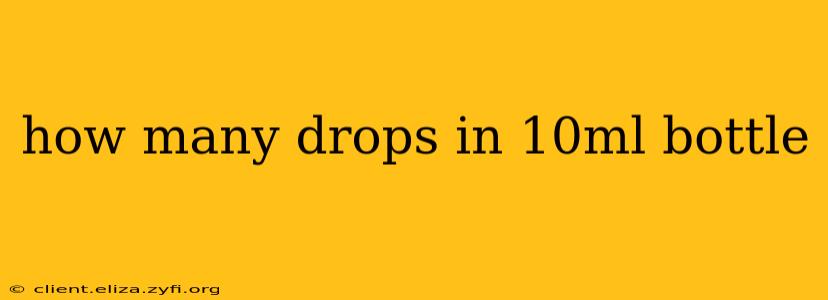How Many Drops Are in a 10ml Bottle? It's More Complicated Than You Think!
The simple answer to "how many drops are in a 10ml bottle?" is: it depends. There's no single definitive answer because the number of drops in a milliliter varies greatly depending on several factors. Let's explore those factors and find a more accurate way to estimate.
What Factors Influence Drop Size?
Several factors influence the size of a single drop dispensed from a bottle, dramatically affecting the total drop count in a 10ml bottle:
- The liquid's viscosity: Thick liquids like honey will produce larger drops than thin liquids like water. Honey's higher viscosity means each drop contains more volume.
- The dropper's design: The size and shape of the dropper tip significantly impact drop size. A wide-bore dropper will deliver larger drops than a narrow-bore one. Some droppers are designed to deliver more precise, consistent drops than others.
- The dispensing technique: How you squeeze the dropper affects the size and volume of each drop. A gentle squeeze produces smaller drops, while a forceful squeeze produces larger ones.
- Temperature: Temperature can subtly affect viscosity, and therefore, drop size. Warmer liquids are usually less viscous than colder ones.
- Surface tension: The liquid's surface tension plays a role in drop formation. Liquids with higher surface tension will tend to form smaller drops.
So, How Can We Estimate?
While we can't give a precise number, we can provide a reasonable range. Under typical conditions (water-like liquid, standard dropper), a milliliter of liquid might contain anywhere from 20 to 100 drops. This means a 10ml bottle could hold between 200 and 1000 drops. This is a wide range, but it highlights the variability involved.
How Many Drops are in 10ml of Water? (A Specific Example)
If we were to specifically look at water using a standard dropper, a more realistic estimate would fall closer to the lower end of that range – perhaps between 200-300 drops. But even this estimate is an approximation.
What about other liquids?
For liquids significantly thicker than water (like essential oils or viscous syrups), you'd expect considerably fewer drops per milliliter, leading to a smaller total drop count in the 10ml bottle. Conversely, extremely thin liquids might produce a greater number of drops.
Why isn't there a precise answer?
The imprecise nature of "drops" as a unit of measurement makes it unsuitable for precise scientific work. Milliliters (or other volumetric units) provide much more reliable and consistent measurements.
Why is this important to know?
Understanding the variability in drop size is crucial in various applications:
- Medicine: Accurate dosing relies on precise measurement, not drops. Always use appropriate measuring devices for medication.
- Science experiments: For accurate experimental results, precise volumetric measurements are necessary.
- Cooking and baking: While a "dash" or "drop" might be used in recipes, for consistent results, it’s better to use standardized measuring tools.
In conclusion, while a quick search might offer a single number, the reality is that the number of drops in a 10ml bottle is highly variable. Always prioritize precise measurement tools when accuracy is important.
